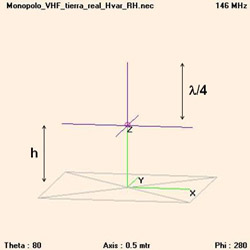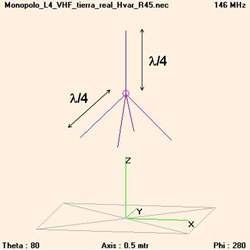Ground planes with 4 radials for VHF/UHF monopoles
Main → VHF/UHF Radio Resource Center → Ground planes with 4 radials for VHF/UHF monopoles |
![]() Este artículo también está disponible en Español (this article is also available in Spanish).
Este artículo también está disponible en Español (this article is also available in Spanish).
![]() Abstract:
Abstract:
Monopole antennas require a ground plane of good electric conductivity in order for its virtual image to be built correctly, enabling a convenient current circulation for efficient radiation purposes. When the monopole is risen over ground, it is a common practice to use an artificial ground plane made of several radials. In this 4NEC2 analysis we consider a quarter-wavelength monopole designed for the 2 meters band, and the effects of using 4 radials at 90 degrees or bent at 45 degrees.
Article first published on 21/12/2009.
1. Monopole with 4 radials at 90 degrees.

Fig.1. Monopole with 4 radials at 90 degrees, modeled in 4Nec2
Monopolo_L4_VHF_tierra_real_Hvar_RH.nec
The antenna consists on a quarter-wavelength monopole and 4 radials of the same length. The radials layout is parallel to the horizontal plane (90 degrees from the monopole) and there are 90 degrees of separation between each pair of radials. In the simulation, we consider an antenna designed for a central frequency of 146 MHz, elevated h = 6 meters (3 times the wavelength) over a real ground of average type.
2. Monopole with 4 radials at 45 degrees.

Fig.2. Monopole with 4 radials at 45 degrees, modeled in 4Nec2
Monopolo_L4_VHF_tierra_real_Hvar_R45.nec
The antenna consists on a quarter-wavelength monopole and 4 radials of the same length. The radials are bent 45 degrees from the horizontal plane and there are 90 degrees of separation between each pair of radials. In the simulation, we consider an antenna designed for a central frequency of 146 MHz, elevated h = 6 meters (3 times the wavelength) over a real ground of average type.
3. Simulation results.
| Monopole with 4 radials at 90 degrees | |||
|---|---|---|---|
| Impedance (ohms) | SWR (50) | Radiation efficiency (%) | Gain (dBi) |
| 24,7 + j8,33 | 2,10 | 53,15 | 5,05 |
| Monopole with 4 radials at 45 degrees | |||
|---|---|---|---|
| Impedance (ohms) | SWR (50) | Radiation efficiency (%) | Gain (dBi) |
| 60,2 + j41,8 | 2,15 | 61,3 | 6,61 |
When the radials are bent 45 degrees, the antenna input impedance rises and the SWR is slightly worse. However, the radiation efficiency changes from 53,15 % to 61,3 %, with a gain improved in 1,5 dB. The 45-degrees layout has the additional advantage of consuming less space when installing the antenna.
Ismael Pellejero - EA4FSI |
 EA4FSI Home |
VHF/UHF Antennas TOC |
VHF/UHF Central |
